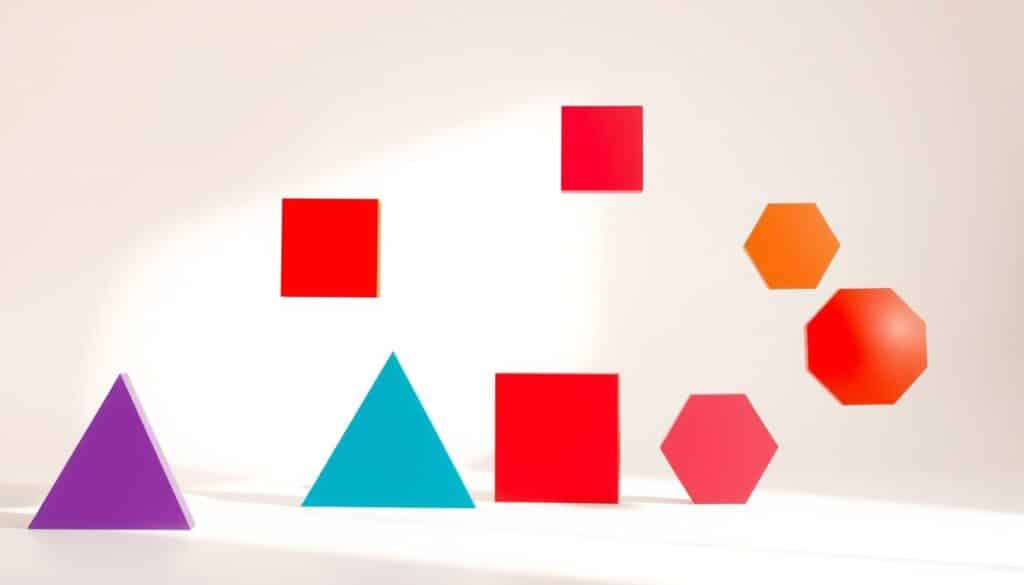Shapes for Kindergarten: Fun & Easy Learning Activities
Learning shapes is key in kindergarten. It’s important to make it fun and engaging for young learners. Shape recognition helps kids solve problems and understand the world.
In kindergarten, kids learn basic shapes like squares, circles, and triangles. This builds a strong base for math later on.

Interactive activities help kids recognize shapes. This is crucial for their brain growth. Fun and easy activities make learning shapes a breeze.
By doing these activities daily, kids improve their spatial awareness and math skills. It’s a great way to make learning fun and engaging.
Key Takeaways
- Kindergarten learning activities should include fun and interactive shape recognition exercises
- Shape recognition is essential for cognitive development and mathematical foundation building
- Interactive activities can enhance spatial awareness and problem-solving skills
- Kindergarten learning activities can be incorporated into daily routines to make learning fun and engaging
- Shape recognition skills are vital for future mathematical concepts and problem-solving abilities
Understanding the Importance of Shapes for Kindergarten Learning
Shapes are key in kindergarten, setting the stage for later success. Studies show that recognizing shapes is vital for early math skills. These skills are important for solving problems and thinking critically. Shapes help kids develop their minds, hand-eye coordination, and sense of space.
Shape recognition in early education has many benefits. It helps kids grasp geometric ideas, improve their visual skills, and spot patterns. Shapes also introduce basic math, like counting and sorting. These are crucial for a strong math foundation.
- Improved cognitive development through problem-solving and critical thinking
- Enhanced spatial awareness and visual processing skills
- Development of early math skills, including counting, sorting, and categorizing
- Introduction to geometric concepts and pattern recognition
By teaching shapes in kindergarten, teachers give kids a strong start. This helps with better thinking, spatial skills, and math. It prepares them for success in school and beyond.
Basic Shapes Every Kindergartener Should Know
Learning basic shapes is key for kindergartners. It helps them understand math and see the world around them. Shapes like squares, circles, triangles, and rectangles are important.
These shapes are everywhere, not just in math books. A square might be in a picture frame, and a circle in a coin. Knowing about shapes helps kids solve problems and improve their hand-eye coordination.

Teaching basic shapes to kindergartners can be fun. Show them shapes in real life, like a triangle in a roof or a rectangle in a book. This helps them learn and grow.
Some important basic shapes and their features are:
- Squares: four sides, four corners
- Circles: no sides, no corners
- Triangles: three sides, three corners
- Rectangles: four sides, four corners
By teaching these shapes, parents and teachers help kids. They build a strong math base and improve their spatial skills. This prepares them for future learning.
Interactive Classroom Activities for Teaching Shapes
Engaging students in interactive classroom activities is key for learning shapes. These activities make learning fun and help students understand shapes better. Teachers can create a fun and supportive learning environment by using these activities.
Studies show that hands-on activities help students remember more and learn better. This is true for learning shapes, where these activities help students see how shapes relate to each other.
Examples of interactive activities include shape hunts, cut-and-paste projects, and shape games. These activities make students think creatively and solve problems while learning about shapes. Adding creative art projects lets students show their imagination and make shapes come alive.
- Shape hunts: Hide shapes around the classroom and have students find them, identifying each shape as they go.
- Cut-and-paste shape projects: Give students shapes to create their own designs, using glue and scissors.
- Movement-based shape games: Use music and movement to teach shapes, having students march, jump, or dance to different shapes.
Using these interactive activities in lesson plans makes learning fun and effective. It helps students understand shapes better. By combining these activities with creative art projects, teachers can prepare students for future math and art classes.
Creative Art Projects Using Different Shapes
Engaging in creative art projects is a great way for kids to learn about shapes. These projects let kids use their imagination and creativity. They make learning fun and interactive. Kids can also use digital tools like shape-themed apps and games to learn more.
Examples of creative art projects include collage making, painting, and drawing. These activities help kids try out different shapes, colors, and textures. They also improve their thinking and spatial awareness. Plus, outdoor activities like nature scavenger hunts can help kids find shapes in nature.

By mixing creative art projects with digital tools and outdoor activities, kids get a full understanding of shapes. This way of learning shapes helps kids do well in math and problem-solving. It prepares them for success in school.
Some popular creative art projects that use shapes are:
- Shape-themed murals
- Geometric pattern making
- Shape sorting games
These activities can be changed to fit different ages and learning styles. They are a great part of any shape recognition curriculum.
Digital Tools and Apps for Learning Shapes
Technology has made learning shapes more fun and interactive for kindergarteners. Digital tools and apps are key in improving shape recognition skills. They offer a great way to add to traditional teaching methods, making learning enjoyable and easy to access.
Educational apps are a great choice for shape recognition. They have puzzles and games that help kids solve problems and improve hand-eye coordination. Apps focus on shape sorting, pattern completion, and tracing shapes.
Recommended Digital Resources
- Shape-themed apps with interactive games and puzzles
- Online shape games that promote problem-solving skills
- Interactive shape videos that demonstrate real-world applications
These digital tools and apps support kindergarten learning activities. They help kids develop important skills like shape recognition. By using these resources daily, parents and teachers can give kids a strong base for future success.
Technology makes learning shapes fun and engaging for young kids. With the right digital tools and apps, learning shapes can be both fun and educational. This sets the stage for a lifelong love of learning.
Outdoor Activities to Reinforce Shape Recognition
Outdoor activities are key in helping kids learn shapes. They boost early math skills and brain growth. Kids learn to solve problems, improve hand-eye coordination, and think critically. Studies show outdoor learning boosts school grades and happiness.
Outdoor games like nature shape hunts and playground spotting help a lot. Kids learn to find shapes in nature and at the playground. For example, a nature hunt lists shapes like leaves and rocks for kids to find.
Outdoor games also get kids moving and exploring while learning shapes. A playground game hides shapes for kids to find. It’s fun alone or with friends, teaching teamwork and social skills.
- Nature shape scavenger hunts
- Playground shape spotting
- Outdoor shape-themed obstacle courses
Adding outdoor fun to their day helps kids grasp shapes better. It improves their math and thinking skills.
Assessment Methods for Shape Recognition Skills
It’s important to check how well kids recognize shapes. This helps us see how strong their math skills and spatial awareness are. Quizzes and puzzles about shapes are great ways to test this.
These tests challenge kids to spot and tell apart different shapes.
Some ways to test shape recognition include:
- Shape sorting games, where kids sort shapes by color, size, or type
- Shape-themed worksheets, where kids find and name shapes
- Watching how kids solve problems, to see if they use shape skills
These methods help teachers understand a child’s math and spatial skills.
Incorporating Shapes into Daily Routines
Learning shapes can be fun for kids when it’s part of their daily life. Parents and teachers can make it exciting with interactive games and art. For instance, at mealtime, kids can spot shapes in their food or use shape-themed dishes.
Bedtime stories and morning games can also teach shapes. These activities boost thinking skills and hand-eye coordination. They also spark a love for learning. Here are some ideas:
- Creating a shape scavenger hunt around the house or backyard
- Using shape-themed puzzles and games to develop problem-solving skills
- Incorporating shape-themed crafts and art projects into daily routines
By adding fun activities to daily routines, kids learn shapes well. They also grow to love learning.
Conclusion: Making Shape Learning a Positive Experience
Exploring shapes in kindergarten can be fun and engaging. Using digital tools and outdoor activities makes learning shapes a positive experience. Research shows kids learn better when they get to explore shapes in hands-on ways.
Teachers can use apps, games, and videos to make learning exciting. Outdoor activities like scavenger hunts help kids see shapes in the real world. These experiences improve their math skills and love for shapes.
The secret to great shape learning is a mix of classroom, digital, and outdoor activities. This approach meets each child’s needs and interests. It makes learning fun and prepares kids for future success.
FAQ
What are the basic shapes every kindergartener should know?
Kindergarteners should learn squares, circles, triangles, and rectangles. These shapes are key to understanding space and math basics.
How can interactive classroom activities help teach shapes?
Fun activities like shape hunts and drawing exercises make learning shapes exciting. They improve thinking, hand-eye coordination, and problem-solving.
What are some creative art projects that incorporate different shapes?
Projects like shape collages and sculptures let kids explore shapes creatively. They boost creativity and shape recognition.
How can digital tools and apps be used to teach shape recognition?
Apps and online games offer tech-based learning for shapes. They support classroom lessons and enhance shape skills.
What outdoor activities can help reinforce shape recognition?
Activities like nature scavenger hunts apply shape skills in real life. They encourage exploration and thinking.
How can shapes be incorporated into daily routines?
Shapes can be part of daily life through games and stories. This makes learning shapes a natural part of the day.
What assessment methods can be used to evaluate shape recognition skills?
Quizzes and puzzles can check shape skills. Observing problem-solving also helps see how well kids understand shapes.
